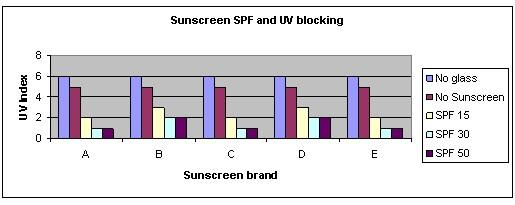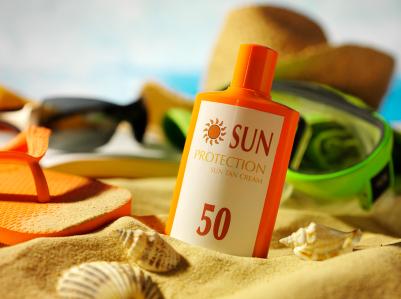| Complexity level: | 6 |
| Project cost ($): | 80 |
| Time required: | The set up and preparation of the test and control groups will require approximately one hour, while observations and recording of data will require one day. |
| Material availability: | May be purchased from a hardware store |
| Safety concerns: | Be extremely careful when handling glass. Adult assistance is required. You should also protect all participants from exposure to the sun. Use sunscreen/umbrellas and ensure that you are properly hydrated |
Hypothesis
Sunscreen products with a higher SPF value are able to block a larger amount of UV radiation from the sun, and are thus more effective.
Overview
Ultraviolet radiation
UV radiation is a component of the electromagnetic spectrum. It is located at the blue end of the electromagnetic spectrum, just below visible light, and is therefore undetectable by the naked human eye. Compared to visible light (400 nm to 700 nm), UV radiation has a relatively shorter wavelength (180 nm to 400 nm) and hence a relatively higher energy level, since energy levels are inversely proportional to wavelength. UV light can be categorized into three sub types, namely UVA (315 nm to 400 nm), UVB (280 nm to 315 nm) and UVC (240 nm to 280 nm). The ozone layer in the atmosphere blocks all UVC radiation, most of UVB radiation but none of the UVA radiation. All three components have different effects on the human body.
As UVA has the longest wavelength compared to the others, it is able to penetrate into our skin and is therefore responsible for causing skin to lose its elasticity. Exposure to large amounts of UVA will lead to premature aging of the skin. On the other hand, UVB does not penetrate our skin due to its shorter wavelength. UVB will only reach the surface of our skin and is responsible for sunburn. UVC has the shortest wavelength among the others, and therefore has the highest energy level. This makes it dangerous for all living organisms on Earth. Fortunately the ozone layer protects us by blocking UVC.
Using sunscreen is one way to protect our skin from UV damage such as sunburn. There are many brands of sunscreen lotions available in the market with different SPF values. The SPF values define the ability of the sunscreen to block UV radiation, especially UVB, that causes sunburns.
One of the simplest ways of measuring UV radiation is to use the UV index. Each unit of the UV index corresponds to about 25mW per square meter of UV radiation. The UV index range is briefly summarized in the table below.
Less than 3 Moderate
Between 3 to 6 High
Between 7 to 9 Very high
More than 9 Extremely high
Scientific Terms
Materials
Materials required for the science fair project are as follows:
- 16 sheets of glass (approximately 550 mm in length x 550 mm wide). These may be obtained from your local hardware store or home depot
- 5 brands of sunscreen with SPF 15
- 5 brands of sunscreen with SPF 30
- 5 brands of sunscreen with SPF 50
- 1 UV meter to measure the UV index readings. Check with the laboratory at your school. Relatively cheap meters are sold on Amazon.com.
- 1 bottle of glass cleaner
- A box of disposable gloves (at least 15 gloves)
- 1 piece of cloth
- A pair of thick safety gloves
- 1 wooden box with no covering on the top (approximately 500 mm in length x 500 mm wide)
Procedure
1. The independent variable in this science fair project is the brand of the sunscreen used and their respective SPF values. The dependent variable is the level of UV index detected after applying the sunscreen. The amount of UV radiation present is measured using the UV meter. The constants (control variables) are the time at which the measurements are taken, the intensity of sunlight on the day of the experiment, and the geological location of the testing area.
2. Divide the sunscreen products into 3 groups according to their SPF value. Within each group, label each brand as A, B, C, D or E accordingly. Next, clean the 16 sheets of glass on both sides using the glass cleaner to remove any dirt on the surface. Label 15 sheets of glass A, B, C, D, E, followed by their respective SPF value. Label one sheet of glass as “None” for the control group.
3. Coat the glass sheets with a layer of the sunscreen according to is label. Use the same amount of sunscreen for each sheet of glass, ensuring that the entire sheet is covered with a thin film of sunscreen. Do not use excessive amounts. Wear the gloves and use your fingers to spread the sunscreen. Ensure that you change gloves before spreading the sunscreen for the next sample.
4. Place the wooden box in a suitable open area that has direct sunlight. There should be no shadows on the box. Place the UV meter inside the box, and record the UV index reading in the table below. Next, cover the box using the sheet of glass labeled “None”, and record the UV indexreading again in the table below. This is the control group reading. Be extremely careful when handling the glass and make sure you use the safety gloves at all times.
5. The sheets of glass with the sunscreen coating will now be tested. Place the glass sheets one at a time on the box and record the UV index measurement. Remember to remove each sheet of glass from the box after measuring its UV index. Record all the measurements in the table given below.

Results
After comparing the UV index of the15 test groups, it was observed that there was a significant difference in the level of UV radiation detected for sunscreen products that had SPF 15 and SPF 30 protection. In other words, a lower UV index was detected for sunscreen products with SPF 30 compared to sunscreen products with SPF 15. On the other hand, there was no significant difference in the UV level detected for the SPF 30 and SPF 50 sunscreen products
| Brand of sunscreen | UV index | ||||
| No glass | No Sunscreen | SPF 15 | SPF 30 | SPF 50 | |
| A | 6 | 5 | 2 | 1 | 1 |
| B | 6 | 5 | 3 | 2 | 2 |
| C | 6 | 5 | 2 | 1 | 1 |
| D | 6 | 5 | 3 | 2 | 2 |
| E | 6 | 5 | 2 | 1 | 1 |
Use the graph below to plot the results of the observations recorded in the table above.

Conclusion
The hypothesis that sunscreen lotion with higher SPF values will block a larger amount of UV radiation , is proven to be true for SPF 15 and SPF 30 sunscreen. However, there was no difference in UV levels when sunscreen products containing SPF 30 and SPF 50 were used.
UV light is responsible for causing the skin to age faster and increasing the risk of skin cancer. The use of proper sunscreen can help to protect our skin from the damage caused by UV light. An SPF 15 lotion blocks 94% of the UV light while SPF 30 lotion blocks 97% of UV light, and SPF 45 blocks 98% of the UV light.
Also consider
What would happen if this science fair project were to be repeated at different times of the day?
The experiment can be also repeated indoors by using a UV lamp.
How about our computer monitors? or televisions? Do they emit UV radiation? Compare the difference in UV radiation emitted, if any, by old CRT (cathode ray television) screens and LCD (liquid crystal display) screens.
References
About forecasts for UV protection - http://www.bom.gov.au/info/about_uv.shtml
Why measure UV? - http://www.solatell.com/Why%20measure%20UV.htm
How to measure the UV index using the UV meter? - http://www.bom.gov.au/info/weatherkit/section2/pdf/uv.pdf
High SPF sunscreens – are they better? -http://www.webmd.com/skin-problems-and-treatments/features/high-spf-sunscreens-are-they-better

